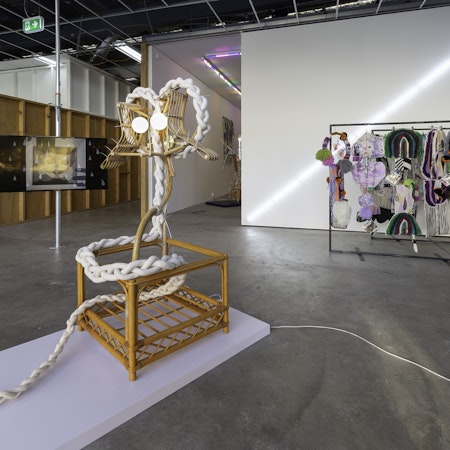Over the past two centuries, the English novelist Mary Shelley has become almost singularly known for her proto science fiction novel Frankenstein; or, The Modern Prometheus (1818). That Frankenstein was first published anonymously, yet included an attributed foreword by Shelley’s husband Percy, offers some context to the suppression of female societal contributions of the time. Often too, the monstrous experiment is erroneously recollected as the novel’s namesake, whereas he also has no attributed name. It is in the author’s spirit, that this project by Sarah Contos metabolises its narratives of identity, power, creation and desire. Like the novel’s scientist protagonist Dr Victor Frankenstein, the artist’s practice embraces a commitment to experimentation, of utilising existing elements, cojoining them, and entwining their forms and materiality towards uncertain ends.
In the Belly of Mary Shelley takes conceptual cues from Frankenstein, reflecting the cultural and scientific fears of the time, while evoking persistent ruminations on life, mortality and humankind’s relationship to the natural world. Contos’s exhibition titles frequently draw upon and pay homage to potent female figures, personas, idols, influences and muses, in acknowledgement of their legacies, and as a means of self-identification. The project developed for Gertrude entwines a kaleidoscope of the biographical, the imagined, and desired to create an evocative narrative of a life cycle.
The project embraces a certain nostalgia for the era of Contos’s own youth, the eighties. It draws upon iconography, symbolism, and sentimentalism from that period, acknowledging the period’s foundational contribution to the formation of Contos’s earliest memories—particularly how she interpreted the world and herself within it. With the sculptural works, recycled cane furniture, wooden beaded room dividers, braided textiles and brushed aluminium pendant lights are reprised as materials with particular historical resonances and evocative triggers. So too does the lullaby-styled musical overlay add to a sense of how one might consider, or construct, a period of innocence. With additional haunting notes, the acoustic soundscape gains a more foreboding sense of unravelling drama.
Central to the exhibition’s installation is a trilogy of films that each represent a particular chapter of life. Frankenstein posed questions of caution around humankind’s interest in experimenting with the creation of new life forms, and the new ethical quandaries and existential threats that might arise out of such. According to Economist journalist Bletchley Park, one of the arising threats in these increasingly uncertain times is, “how to ensure that artificial intelligence neither becomes a tool of unchecked malfeasance nor turns against humanity.”1 For Contos, with her predilection for the possibilities within collage and assemblage, such technological advancements avail potential for how one might create new narratives. Utilising emerging generative AI tools, the artist has employed a program (now already redundant) to generate fictionalised imagery upon her direction. These images, born of descriptional instruction, animated together in a manner almost rudimentary and arcane, elaborate temporal possibilities for her collage to develop over time.
In positioning the project as emanating from within the belly, Contos draws deeply upon a methodology of intuition, and the effects registering internally of external environments and events. The exhibition connotes a sense of gut feeling, an instinctual emotional response, rather than one reached through strict reason and logic. In a manner, this offers cues on Contos’s artistic drive as one that acknowledges emotional complexity and uncertainty. Through this, works can effectively hold multiple and even contrary lines of thinking, varied sensorial strains that might more readily convey divergent perspectives simultaneously. Such is Contos’s approach to exhibition making, that it embraces a sense of a total environment wherein the components work collaboratively to maximalise their collective reverberations, while also reverberating in differing ways.
With Contos as dramaturg, the sculptures interrelate as a cast of characters, forming a relationship to one another through from, light, materiality and structural tension. They gaze over the series of films that circulate around the environment, providing tangible tensile organisation, and providing counterbalance to the dynamic freneticism of the animated films. The configuration has been orchestrated to unfold as one navigates through the environment, revealing itself through the process of encounter from outside of the building and as one then moves through the internal architecture. Illuminated overnight, the project functions to progress across the course of the day, evolvingly becoming more theatrical as dusk shifts to night. In the Belly of Mary Shelley is, at its core, about flux. It is a theatre that is animated by each visitor, a stage inviting audiences to play a part, introduced by costumes yet to be adorned.
[1] Park, Bletchley, ‘The world wants to regulate AI, but does not know how,’ The Economist, 24 October 2023.
